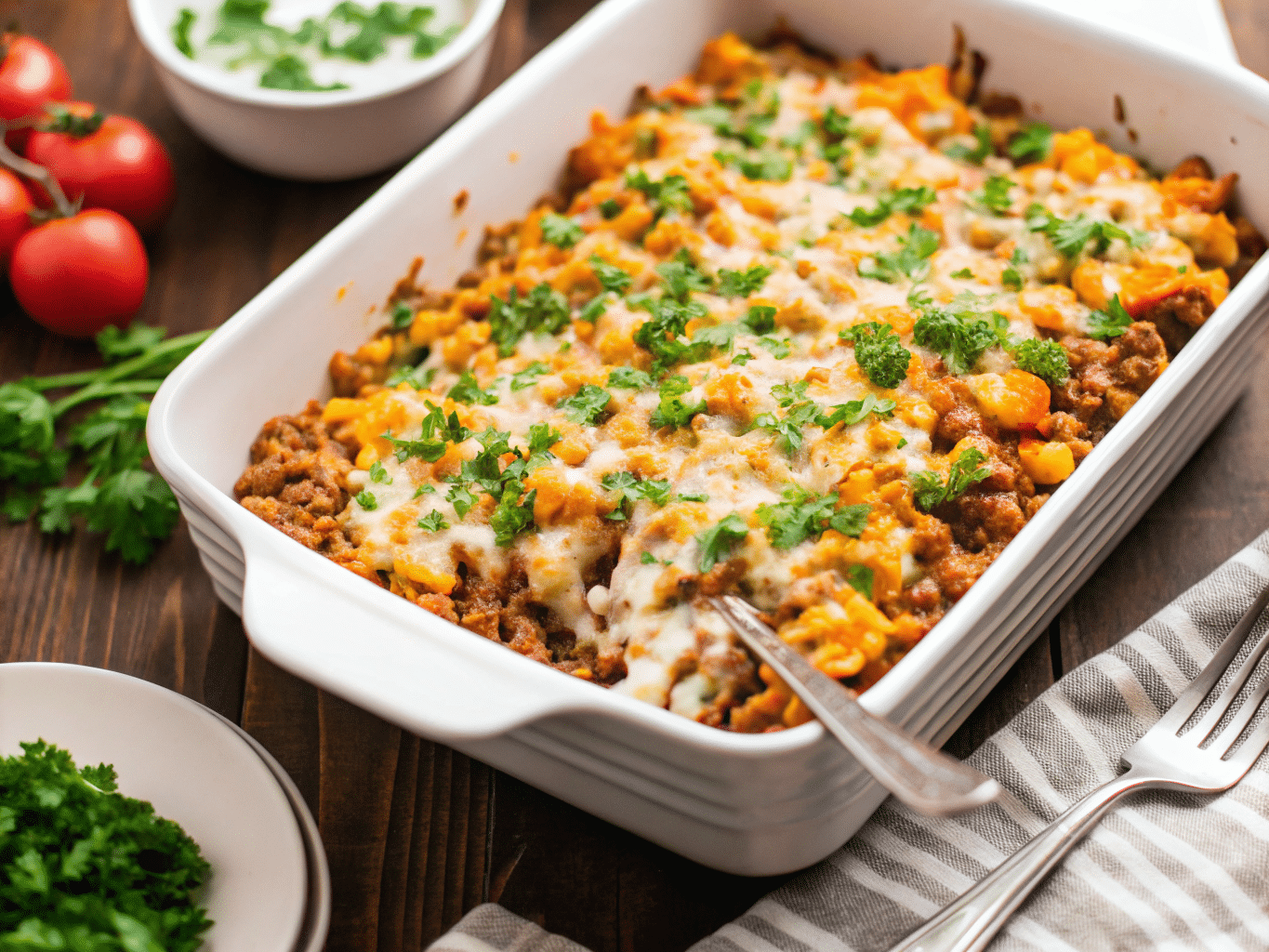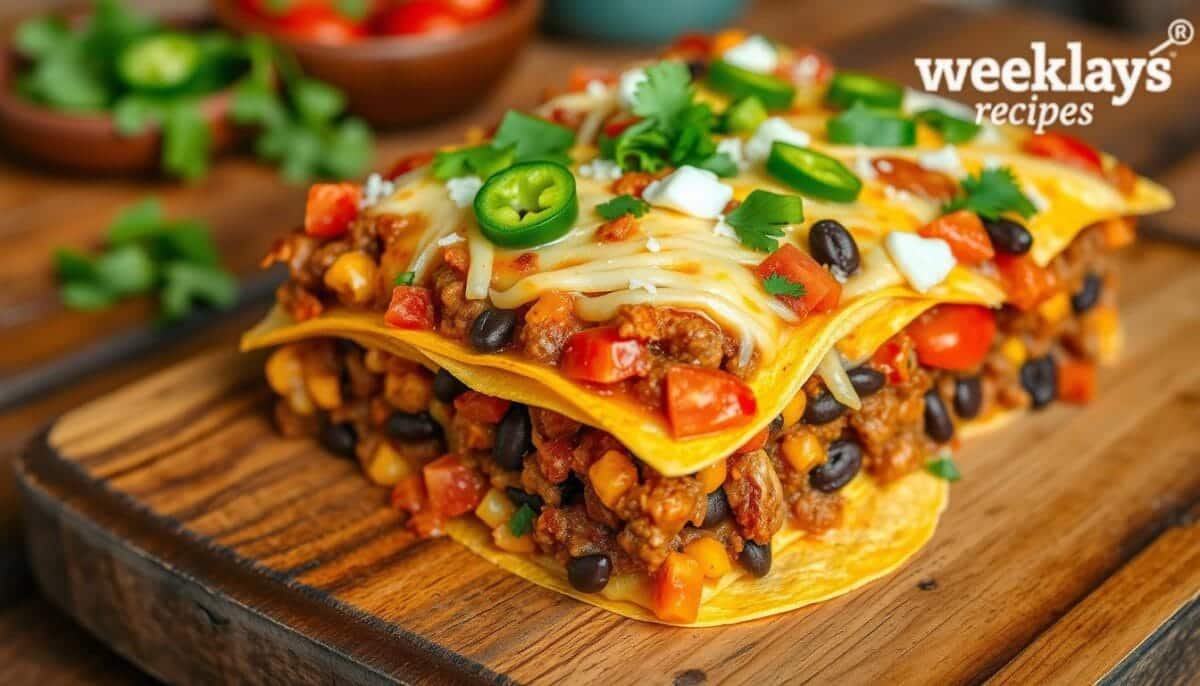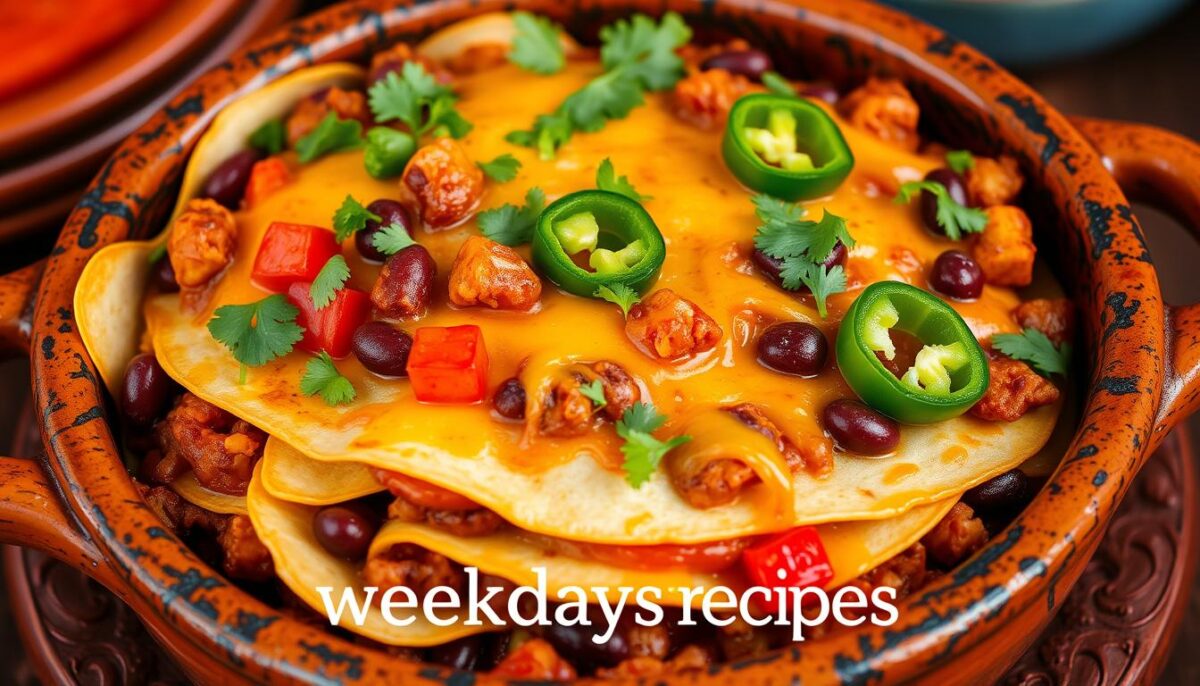Mexican Casserole Recipe always brings me back to my childhood kitchen, where the scent of cumin and melted cheese meant comfort was in the oven. Mom would layer beans, beef, and rice like a seasoned artist, humming to ranchera tunes. That bubbling dish wasn’t just dinner; it was a warm hug on a weeknight. Now, I make my version—healthier, quicker, but still dripping with flavor and memories. Whether you’re feeding your family or reliving your dinnertime traditions, this recipe delivers the rich, cheesy goodness of those golden, oven-baked moments.
The Essential 5 Components of a Perfect Casserole
Exploring Protein, Grains, Vegetables, Sauce, and Cheese
Behind every mouth-watering Mexican casserole recipe lies a simple, golden formula: the five classic casserole components. Each one brings balance to the dish—flavor, texture, and nourishment.
- Protein – Whether it’s lean ground beef, turkey, or shredded chicken, the protein anchors the casserole, adding heartiness and depth.
- Grain – Brown rice is a go-to for its whole grain benefits and texture, but quinoa or even tortillas work beautifully.
- Vegetables – Bell peppers, onions, tomatoes, and green chilies bring freshness, color, and bold Southwestern flavor.
- Creamy Base – Refried beans or Greek yogurt replace heavy sauces with lighter, flavorful alternatives.
- Cheese – A must. Sharp cheddar and mozzarella melt into every layer for that cheesy pull and irresistible crust.
Understanding these components lets you riff on the recipe confidently—whether you’re adapting it for picky eaters or cleaning out the fridge.
Why the Structure Matters for Taste and Texture In Mexican Casserole
It’s not just about what you include—it’s how you layer it.
First comes the creamy base (refried beans), creating a soft foundation. Then the seasoned rice-and-protein blend forms the heart. Cheese is scattered throughout, not just on top, for melty bites in every scoop. Vegetables are nestled in, adding sweetness and crunch between the richness.
This strategic layering helps each bite hit that perfect balance—creamy, chewy, tender, and crisp.
Mexican Casserole Recipe Origin and Cultural Roots
History of Mexican Casserole and Tex-Mex Fusion
The Mexican casserole recipe isn’t a dish born in a single town or moment—it’s a flavor-packed fusion of tradition and adaptation. Rooted in the bold spices and rustic ingredients of Mexican cuisine, it evolved as Mexican families brought their cooking north and adapted it to American kitchens.
In the early 20th century, as Mexican immigrants settled in the U.S., especially in Texas, they blended their native flavors with local ingredients. Tex-Mex was born—chili con carne, enchiladas, tacos… and yes, eventually, casseroles.
Layered, hearty, and built for a crowd, the Mexican casserole emerged from this fusion. It mirrored classic Mexican dishes—like enchiladas or chilaquiles—but simplified for busy American life, using oven-friendly ingredients like shredded cheese, canned beans, and cooked rice.
Regional Variations in Mexico and the USA
Although the exact Mexican casserole recipe might not be something you’d find in a traditional Mexican abuela’s cookbook, similar layered dishes have long been a part of Mexican cuisine—especially in northern Mexico. Think pastel azteca, a lasagna-style layered tortilla dish with salsa and meat.
In the U.S., especially throughout the Southwest, home cooks began layering beans, meat, and tortillas into casseroles during the mid-century boom of processed and pantry-stable foods. It became a weeknight hero: fast, flexible, and deeply satisfying.
Today, you’ll find countless variations:
- In California, it might feature black beans, avocado, and roasted corn.
- In Texas, expect bold chili powder and extra cheddar.
- In New Mexico, you’ll taste green chilies in every bite.
Ingredients You Need for the Ultimate Mexican Casserole
Fresh and Pantry Staples: Meats, Rice, Beans, Cheese
Creating the perfect Mexican casserole recipe starts with the right blend of ingredients—those you probably already have in your kitchen. It’s a budget-friendly, family-approved way to bring bold, satisfying flavors to your table without fuss.
Here’s what you’ll need:
| Ingredient | Why It Works |
|---|---|
| Lean Ground Beef | Offers rich flavor and protein; turkey or chicken are great substitutes |
| Cooked Brown Rice | Adds fiber and whole grains; can sub with quinoa or instant rice |
| Refried Beans | Makes the casserole creamy; use black or pinto beans |
| Greek Yogurt | A healthier swap for sour cream, adds tang and texture |
| Tomatoes with Green Chilies | Brings acidity and Southwest flavor (like Rotel) |
| Onions & Bell Peppers | Adds freshness, color, and crunch |
| Fresh Garlic | Boosts aroma and depth |
| Cheese (Cheddar & Mozzarella) | Melts beautifully; sharp cheese enhances flavor without using too much |
| Spices (Chili Powder, Cumin, Cayenne) | Create the signature Mexican flavor with heat and earthiness |
These ingredients come together to form that magical combination of creamy, cheesy, spicy, and hearty—everything you want in a comfort meal.
Healthy Swaps Like Greek Yogurt and Lean Beef In Mexican Casserole
A classic Mexican casserole recipe doesn’t have to be heavy or overly indulgent. You can lighten it up while keeping the flavor big:
- Swap sour cream for plain Greek yogurt—it adds creaminess with less fat and more protein.
- Use lean ground beef, or replace it with ground turkey or plant-based crumbles.
- Go easy on the cheese by using bold, sharp varieties. They provide more flavor per ounce.
- Load up on vegetables—bell peppers, corn, even zucchini or spinach can work their way in.
How to Make the Best Mexican Casserole Recipe at Home
Step-by-Step Instructions from Sautéing to Layering
Making this Mexican casserole recipe is all about layering simple, flavorful steps. It’s easy enough for a weeknight but satisfying enough to serve at gatherings.
1. Preheat and Prep
- Preheat your oven to 350°F (177°C).
- Lightly coat a 9×13-inch casserole dish with nonstick spray and set aside.
- Make sure your rice is already cooked. Brown rice takes time—plan ahead or use quick-cook versions.
2. Sauté the Veggies
- Heat 1 tbsp of olive oil in a deep skillet or Dutch oven over medium-high heat.
- Add chopped onion, green bell pepper, and red bell pepper.
- Sauté until softened (about 5 minutes).
3. Add the Meat and Spices
- Add 1 lb of lean ground beef (or turkey/chicken) to the skillet.
- Sprinkle in:
- 2 tbsp chili powder
- 1½ tsp cumin
- ½ tsp kosher salt
- ½ tsp ground black pepper
- ¼ tsp cayenne pepper
- Cook until meat is browned and no longer pink. Then stir in 2 cloves minced garlic.
4. Mix in Rice and Yogurt
- Remove skillet from heat.
- Stir in:
- 2 cups cooked brown rice
- 1 cup plain Greek yogurt
This forms a creamy, protein-packed filling with a kick of flavor.
5. Layer the Casserole
In your prepared dish, layer as follows:
- Spread refried beans (1 can, 15 oz) evenly on the bottom.
- Sprinkle with ¼ cup each cheddar and mozzarella cheese.
- Add a layer of drained tomatoes with green chilies (10 oz can).
- Top with the rice and meat mixture.
- Finish with the remaining ½ cup cheddar + ½ cup mozzarella.
Baking Tips for Perfect Texture and Flavor
- Bake uncovered for 15 minutes until heated through.
- Broil for an additional 3–4 minutes for golden, bubbly cheese.
- Let it rest 5 minutes before serving to set the layers.
Top with chopped cilantro and green onions for a pop of color and flavor.
Next up is Part 6: Easy Variations to Fit Your Diet — we’ll look at how to make this dish vegetarian, gluten-free, or adjusted for spice preferences. Ready to go?
Easy Variations to Fit Your Diet
Vegetarian and Gluten-Free Casserole Variations
One of the best things about a Mexican casserole recipe is how easy it is to adapt. Whether you’re cooking for vegetarians, gluten-sensitive family members, or just looking to eat lighter, this dish has room for it all.
To Make It Vegetarian
- Skip the meat and add more beans. Use a full can of pinto or black beans, or even a mix.
- Add in extra veggies like zucchini, corn, or mushrooms to bulk up the filling.
- For a protein boost, toss in some tofu crumbles or textured vegetable protein (TVP).
To Make It Gluten-Free
- Good news: this casserole is naturally gluten-free.
- Just double-check that your canned beans and tomatoes are labeled gluten-free and haven’t been processed with flour or wheat-based additives.
- If layering with tortillas (in other variations), choose certified gluten-free corn tortillas.
Spice Level Customizations and Low-Carb Swaps
Some like it hot, and some definitely do not. Luckily, this casserole makes it easy to adjust for spice and carb preferences.
Mild or Kid-Friendly Version
- Use mild diced tomatoes with green chilies.
- Skip the cayenne pepper and cut back a bit on the chili powder.
- Add a dollop of sour cream or yogurt on top to mellow out any lingering heat.
To Make It Spicier
- Use hot green chilies or add a dash of chipotle powder.
- Mix in sliced jalapeños or a few dashes of your favorite hot sauce.
- Top with a sprinkle of pepper jack cheese for an extra spicy finish.
Low-Carb Version
- Swap the rice for cauliflower rice.
- Limit the beans or use lower-carb varieties like black soybeans.
- Skip the tortillas if using them in layered versions.
Serving Ideas for Your Mexican Casserole
What to Serve on the Side: Salads, Bread, and Dips
A hearty Mexican casserole recipe is almost a complete meal by itself, but the right sides can elevate your dinner from delicious to unforgettable. Whether you’re entertaining or just treating the family, these pairings balance out the richness of the casserole with freshness, crunch, or a touch of sweetness.
Top Side Dishes to Try
| Side Dish | Why It Works |
|---|---|
| Grilled Corn Salad | Adds sweetness and smoky char that contrast perfectly |
| Mexican Cornbread | Soft, crumbly, slightly sweet—a classic pairing |
| Avocado Tomato Salad | Light and zesty to cut through the cheese and meat |
| Tortilla Chips & Guac | For scooping or dipping — always a hit |
| Cilantro Lime Rice | Double up on grains with a citrusy twist |
| Black Bean Dip or Salsa Verde | Adds tang and protein in a lighter form |
Pair your casserole with sweet roasted sweet potatoes or a bowl of spicy coleslaw to round out the table.
Fun Ways to Repurpose Leftovers Like Burrito Bowls
Got leftovers? Perfect. This casserole transforms beautifully into brand-new meals the next day.
Creative Ways to Reuse Mexican Casserole Leftovers
- Burrito Bowls – Scoop leftovers into a bowl and top with guacamole, salsa, and shredded lettuce.
- Stuffed Peppers – Hollow out bell peppers and bake filled with leftover casserole.
- Quesadillas – Sandwich casserole between two tortillas with extra cheese and grill until crispy.
- Breakfast Hash – Sauté with scrambled eggs and top with hot sauce for a savory breakfast twist.
These ideas turn one dish into multiple meals — perfect for meal prep lovers or busy families.
Make Ahead, Storage, and Freezer Tips
Meal Prep Tips to Save Time During Busy Weeks
One of the best things about this Mexican casserole recipe is how well it fits into your weekly routine. It’s a total winner for meal prep — hearty enough to last, and even better after the flavors sit.
Here’s how to plan ahead without losing a minute of flavor:
To Make Ahead
- Cook the rice and brown the meat up to 1 day in advance.
- Chop your veggies (onions, bell peppers, garlic) and refrigerate in sealed containers.
- Assemble the full casserole the night before. Cover tightly with foil or plastic wrap and refrigerate.
- When you’re ready to cook, just pop it in the oven — add 5 extra minutes to the baking time since it’s starting cold.
Prepping Tip: Want to get ahead on the weekend? Assemble and freeze your casserole (details below), then thaw and bake when needed!
How to Store, Freeze, and Reheat Without Losing Flavor
Refrigerator Storage
- Store leftovers in an airtight container in the fridge for up to 5 days.
- You can also leave the casserole in the original baking dish—just cover tightly with foil.
Freezing Instructions
- This casserole freezes like a champ.
- Freeze in a freezer-safe dish, wrapped tightly in foil and plastic wrap, for up to 3 months.
- Label it with the date and reheating instructions.
Reheating Tips
- From the fridge: Reheat individual portions in the microwave with a splash of water or broth to keep it moist.
- From the freezer: Thaw overnight in the fridge, then bake at 350°F for 20–25 minutes, covered with foil. Broil for the last 3–4 minutes if you want that bubbly cheese top.
Why Mexican Casseroles Are Beloved Comfort Food
The Nostalgia and Popularity Behind the Dish
There’s something timeless about pulling a bubbling, cheesy Mexican casserole recipe out of the oven. It doesn’t just feed your body — it feeds your memories.
From school nights to weekend potlucks, casseroles have long been the symbol of comfort and home. The Mexican version adds a vibrant twist with bold spices, beans, chilies, and cheese that make each bite an event. It’s the type of dish that brings everyone back to the table — seconds guaranteed.
In many families, the aroma of taco seasoning and roasted peppers triggers warm memories: sitting at the counter waiting for dinner, grandma spooning a heap onto your plate, or sneaking extra cheese before the pan hit the oven.
That’s why this recipe never goes out of style — it’s customizable, comforting, and classic.
Fun Facts and Family-Friendly Appeal
- Casseroles gained major popularity in the 1950s, when quick-fix dinners became essential for busy households.
- The term “casserole” comes from the French word casse, meaning pan.
- The first casserole dish in the U.S. was patented in 1913 — long before our beloved Tex-Mex twist was born.
- Mexican casseroles are often compared to 7-layer dip or enchiladas, but offer a no-roll, hands-free version of those flavors.
Even picky eaters can find something to love here. And with a little creativity, this dish evolves into burritos, taco bowls, and even breakfast hashes.
For more recipes, follow me on Facebook and Pinterest
FAQs: Mexican Casserole Recipe
What is Mexican casserole?
A Mexican casserole is a layered, oven-baked dish inspired by traditional Mexican and Tex-Mex flavors. It usually includes seasoned ground beef or chicken, cooked rice or tortillas, beans, cheese, and vibrant veggies like peppers and onions. The dish is baked until bubbly and golden, making it a go-to comfort food that’s easy to prepare and packed with flavor.
What are 5 components of a casserole?
The five key components of a casserole are:
- Protein – like ground beef, turkey, or beans.
- Grain or Base – such as rice, pasta, or tortillas.
- Vegetables – onions, peppers, tomatoes.
- Sauce or Creamy Element – Greek yogurt, cream, or beans.
- Cheese or Topping – cheddar, mozzarella, or breadcrumb topping.
These elements create the balanced layers that make casseroles hearty, flavorful, and satisfying.
Where did Mexican casserole originate?
The Mexican casserole recipe was born out of Tex-Mex cuisine, a fusion of Mexican and American cooking traditions. While not traditionally Mexican, it evolved in the southwestern United States as a way to incorporate beloved Mexican ingredients into a family-friendly, baked meal format.
What is the history of casseroles?
Casseroles date back centuries, but in the U.S., they became wildly popular in the 1950s, thanks to affordable cookware and a cultural shift toward one-dish meals. Originally rooted in European baking traditions, casseroles evolved into hearty family meals that were simple to assemble and easy to share.
What is a fun fact about casseroles?
Here’s a fun one: the word “casserole” comes from the French word “casse,” meaning a deep pan. And during WWII, casseroles became a patriotic way to stretch ingredients while feeding large families. Plus, nearly every culture has its own casserole version — from lasagna to shepherd’s pie.
When and why did the casserole gain popularity?
Casseroles gained momentum in the mid-20th century because they were budget-friendly, fed large families, and minimized clean-up. The rise of canned soups and boxed pasta helped fuel their convenience. The Mexican casserole, specifically, gained traction as American palates craved spicier, bolder flavors and faster meals.




7 thoughts on “The Best Mexican Casserole Recipe for Easy Family Dinners”